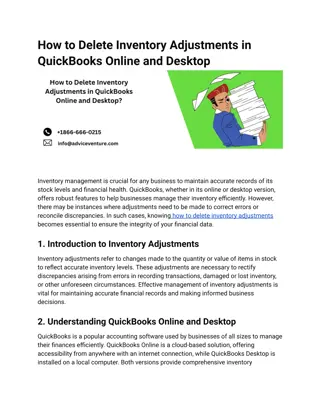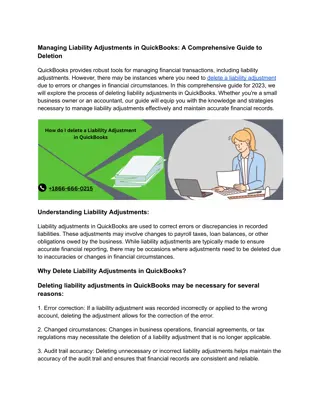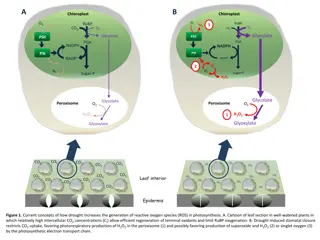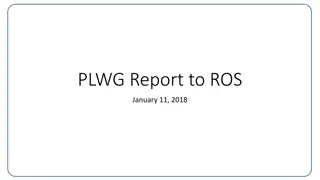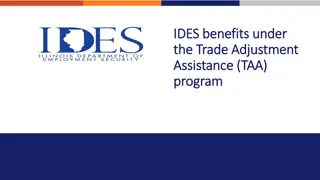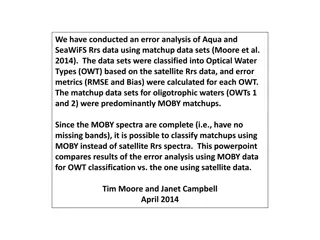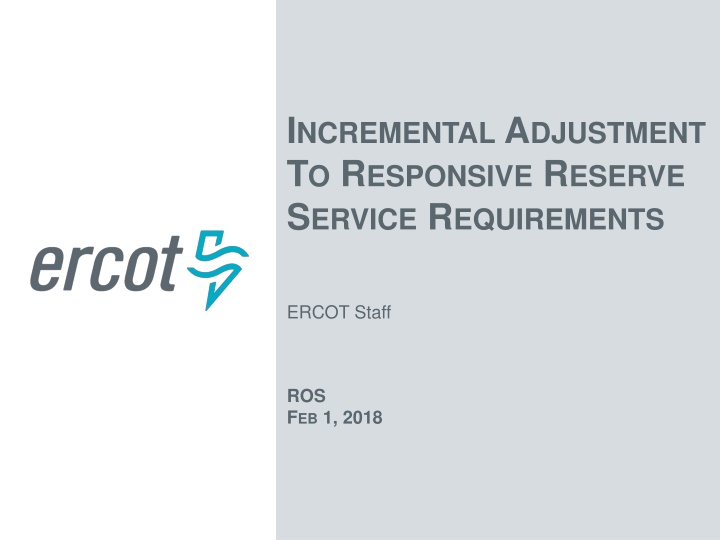
ERCOT Staff Responsive Reserve Service Study
"Explore the details of ERCOT staff's study on ensuring sufficient capacity for frequency excursions through responsive reserve service. Learn about the methodology, hydro response characteristics, and efficacy assessments for maintaining system stability."
Download Presentation

Please find below an Image/Link to download the presentation.
The content on the website is provided AS IS for your information and personal use only. It may not be sold, licensed, or shared on other websites without obtaining consent from the author. If you encounter any issues during the download, it is possible that the publisher has removed the file from their server.
You are allowed to download the files provided on this website for personal or commercial use, subject to the condition that they are used lawfully. All files are the property of their respective owners.
The content on the website is provided AS IS for your information and personal use only. It may not be sold, licensed, or shared on other websites without obtaining consent from the author.
E N D
Presentation Transcript
INCREMENTAL ADJUSTMENT TO RESPONSIVE RESERVE SERVICE REQUIREMENTS ERCOT Staff ROS FEB 1, 2018
Responsive Reserve Service (RRS) System Inertia 2016 RRS is procured to ensure sufficient capacity is available frequency excursions during unit trips. to respond to To consistently meet BAL-003 Response Interconnection Obligation, ERCOT must plan not to activate UFLS for loss of 2750 MW of generation. UFLS relays will shed firm load if frequency drops to 59.3 Hz (5% of total ERCOT load). Frequency Responsive Reserve Requirements 2017 ERCOT plans to maintain frequency nadir at or above 59.4 Hz for loss of 2750 MW (0.1 Hz margin). PUBLIC 2
RRS Study Methodology A set of recent cases at varying inertia levels are selected to to represent a wide range of expected future inertia conditions. Following assumptions are applied to each case/study, Model 1150 MW of PFR from Generation Resources. Generation mix when, Inertia < 250 GW s: 30% Coal + 70% Gas Inertia 250 GW s: 15% Coal + 85% Gas Load Resources providing RRS will trip at 59.7 Hz, with a delay of 0.416 s (relay delay = 0.333 s; breaker action = 0.083 s). Load damping factor was assumed to be 2% at the system level. Trip 2750 MW of generation simultaneously and identify the amount of LR needed to maintain frequency at 59.4 Hz. PUBLIC 3
Hydro Response Characteristic In Real Time, a portion of RRS is provided by Hydro resources operating in synchronous condenser mode via under-frequency relay action (i.e. not a typical governor response). Hydro resources provide response when frequency drops below 59.8 Hz, and are required to reach their HSL (equals their RRS responsibility) within 20 seconds after frequency trigger is met. PUBLIC 4
Discrepancy between RRS Study & Real Time Operations These unique response characteristics of Hydro resources that operate under synchronous condenser fast response mode have not been included in previous studies to determine RRS requirement. However, ~80% of the time Hydro Resources operating in synchronous condenser fast response mode carry more than 240 MW of RRS. PUBLIC 5
RRS Efficacy Study Methodology To assess the efficacy of Hydro resources that provide RRS via synchronous condenser fast response mode, additional RRS studies were recently completed using updated cases at varying inertia levels. In these studies for Hydro resources, models were created to mimic actual synchronous condenser fast response mode response. These models were benchmarked with actual plant level data (from seasonal RRS tests). PUBLIC 6
Hydro Model Benchmarking Unit Level Each Hydro unit s response was benchmarked. Below is comparison for a particular Hydro resource s response from the model created and its seasonal RRS test data. PUBLIC 7
Hydro Model Benchmarking System Level Models were created for 11 Hydro resources (a total of 240 MW RRS). PUBLIC 8
RRS Efficacy Study Methodology Once the Hydro response was benchmarked, additional studies were conducted at varying inertia levels. Following assumptions were applied to each case/study, Model 240 MW of PFR from hydro resources operating in synchronous condenser mode using the benchmarked models and 910 MW of PFR from Generation Resources. All other assumptions were consistent with previous RRS studies. Trip 2750 MW of generation simultaneously and identify the amount of LR needed to maintain frequency at 59.4 Hz. PUBLIC 9
Low Inertia Condition (150 GW*s) PUBLIC 10
Increased RRS need in Low Inertia Condition (150 GW*s) An additional 125 MW LR required to maintain C point at 59.40 Hz when 240 MW (out of 1150 MW) is provided by Hydro resources. PUBLIC 11
Mid Inertia Condition (260 GW*s) No additional LR is required to maintain C point at 59.40 Hz when 240 MW (out of 1150 MW) is provided by Hydro resources. PUBLIC 12
Hydros Impact on PFR Chart below shows additional PFR needed OR additional LRs needed when 240 MW (out of 1150 MW) of RRS is provided by Hydro resources at varying system conditions (inertia levels). Additional PFR = Additional LR Equivalency Ratio PUBLIC 13
Actual Value of Hydro Providing RRS vs System Inertia Chart below shows equivalency ratio of Hydro resources versus PFR at varying system conditions (inertia levels). PUBLIC 14
Summary Efficacy studies show that with Hydro resources providing RRS in synchronous condenser mode, when; system inertia is at or above 250 GW.s, current RRS procurement quantities are sufficient. system inertia is below 250 GW.s, additional RRS will be needed to keep system frequency from falling below 59.40 Hz for a loss of 2750 MW. Beginning Feb 1, 2018 ERCOT will procure additional quantities of RRS during hours when Hydro s equivalency ratio is less than 1. Posted RRS requirements for Feb thru May 2018 will be updated. (Completed Jan 23, 2018) Post NPRR 815 implementation, these RRS quantities will be updated to reflect 60% limit on RRS from Load Resources. RRS quantities for September through December, 2018 may be adjusted if an alternate solution is not implemented by that time. 15 PUBLIC 15
Additional RRS Needed Current Methodology (50% Lim) HE 1 2 3 4 5 6 7 8 9 10 11 12 13 14 15 16 17 18 19 20 21 22 23 24 Jan 133 133 133 133 133 133 145 145 145 145 145 145 145 145 145 145 145 145 141 141 141 141 133 133 Feb 161 161 167 167 167 167 141 141 141 141 141 141 141 141 141 141 141 141 141 141 141 141 161 161 Mar 167 167 167 167 167 167 141 141 141 141 145 145 145 145 145 145 145 145 145 145 145 145 167 167 Apr 167 167 167 167 167 167 137 137 137 137 145 145 145 145 94 94 94 94 145 145 145 145 167 167 May 141 141 137 137 137 137 96 96 96 96 10 10 10 10 0 0 0 0 10 10 10 10 141 141 Jun 0 0 10 10 10 10 0 0 0 0 0 0 0 0 0 0 0 0 0 0 0 0 0 0 Jul 0 0 0 0 0 0 0 0 0 0 0 0 0 0 0 0 0 0 0 0 0 0 0 0 Aug 0 0 0 0 0 0 0 0 0 0 0 0 0 0 0 0 0 0 0 0 0 0 0 0 Sep 44 44 44 44 44 44 10 10 10 10 0 0 0 0 0 0 0 0 0 0 0 0 44 44 Oct 133 133 133 133 133 133 141 141 141 141 44 44 44 44 10 10 10 10 96 96 96 96 133 133 Nov 167 167 167 167 167 167 137 137 137 137 141 141 141 141 141 141 141 141 141 141 141 141 167 167 Dec 167 167 167 167 167 167 133 133 133 133 141 141 141 141 141 141 141 141 141 141 141 141 167 167 16 PUBLIC 16
Potential Longer Term Solutions 1. Continue to procure additional quantities of RRS during hours when Hydro s equivalency ratio is less than 1. 2. Change DAM to include hydro s equivalency ratio such that any shortfall in RRS/PFR is accounted for during procurement. Change settlement so that Hydro Resources providing RRS are paid the multiplication of the RRS MCPC, the Hydro Equivalency Ratio for the hour and the Awarded Quantity. 3. Modify performance capabilities of Hydro resources. 4. Consider comprehensive changes to Ancillary Service suite to align system needs and capabilities. 17 PUBLIC 17
Divider Slide DISCUSSION Divider Slide (optional) PUBLIC 18



